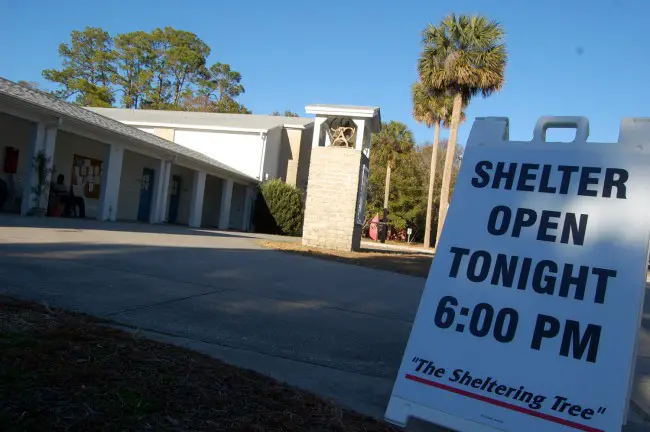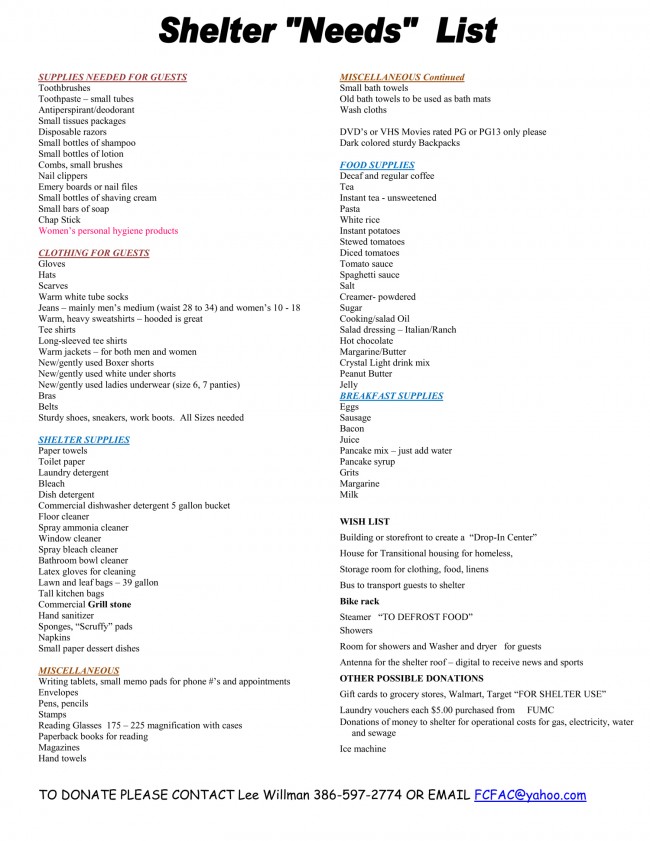woman as a sheltering tree drawing

All of last year, the Sheltering Tree, Flagler County's only overnight cold-weather shelter for the homeless, opened its doors for 40 nights. On Wednesday evenings, as temperatures were heading into the 20s, the shelter was opening its doors for the 22nd night so far this season. And the winter is just beginning.
"Last year we didn't open until January 1," says Carla Traister, the center's director and a recipient of the President's Volunteer Service Award.
The shelter opens every night temperatures are forecast to be 40 or below. That's where temperatures will be through Saturday night, likely ensuring that by week's end, the shelter will have opened 25 times this season. The center, at the First United Methodist Church of Bunnell at 205 North Pine Street–whose pastor, Rev. Beth Gardner, is a quiet force for good in the county–converts the church's large Fellowship Hall into a dormitory and cafeteria on needed nights, accommodating up to 32 men and women. It's the same hall that witnesses weddings, funerals and other gatherings.
When the shelter is open, it's usually full. Cots provided by the Red Cross are arranged in rows, most, exhausted from days spent in few to no comforts outside, go to sleep after dinner, and the television goes off at 10 p.m. On successively cold nights, guests can put a sign on their cot and know that they'll have the same cot the following night. But it's not an all-day shelter: guests are to leave immediately after an early breakfast. It's not a hotel, either: those who register in the evening but choose to leave the place in the evening, to go out somewhere, will not be allowed back in.
Every Wednesday evening, no matter what the temperature, the shelter hosts its Soul Cafe–a full, hot meal for anyone in the community. That meal, which averages 45 to 50 people a week, and has had up to 70, has been drawing 25 to 50 percent more people than last year. "I don't know whether it's because the word is getting out or because we have more people in need," Traister says.

The entire operation is run by volunteers. The food is contributed by the volunteers. The clothes and shoes that homeless men and women are able to take are also all donated. But the harsher the season, the greater the needs. This season isn't harsher merely because of the weather, but because of the economy's accumulated hardships over the last two to three years. The shelter used to accommodate many more "overflow" guests from the Daytona Beach area, bused here by volunteers from Halifax Ministries when three shelters in Volusia County are at capacity. These days, the Sheltering Tree is seeing a greater proportion of local guests. It does, however, get a monetary contribution for caring for Volusia men and women.
There's seldom any trouble in the shelter. "You have to be here to appreciate what these people appreciate," says Charlie Ericksen, one of the core volunteers. More often, it's medical issues that intervene and require a transport to the local hospital. On one occasion the police did come in following a disturbance, but officers talked with the guests, calmed things down, didn't take anyone away, and left.

The Sheltering Tree doesn't like to refer to the men and women it cares for as "overnighters" or even "homeless." It refers to them as guests. Calling local guests "residents" of Flagler County would be a misnomer, too: they haveno residence. And Flagler County, particularly Palm Coast, are poorly set up, purposefully or inadvertently, to care for the homeless (although Flagler Palm Coast High School began providing showers once a month for the homeless, and the school's cosmetology students provide haircuts and other such services, free). Absent other systematic services, the task falls on the Sheltering Tree's volunteers, who this year have drawn a corp of some 100 individuals organized in teams of five who parcel out the operation's responsibilities–the regular cooking of evening and morning meals when the shelter is open, the registration of guests, the overnight supervision, which always entails at least two volunteers staying up all night with the guests, the organization and dispensing of clothes, and so on. When all the people who've donated some time and effort are included, the number of volunteers climbs to 200. It's a good year, as far as that's concerned: Many more people are wanting to help with their time.
But the shelter needs food, clothes, goods of all sorts, especially as the cold weather is taxing its resources more early and more persistently than in the two previous two years it was open. One example: December's electric bill was $600. There's also a great deal of wear and tear on the shelter's resources. The griddle is broken, the washing machine needs work. Cots seem to be breaking often, sometimes one a night, as heavier people use them. They're expensive: $45 for regular cots, $75 for heavy duty ones.
Below is the shelter's wish list. Phone numbers and the address of where to drop off needs are in the small box to the left, at the beginning of this story.

Source: https://flaglerlive.com/16519/flagler-sheltering-tree-needs/


0 Response to "woman as a sheltering tree drawing"
Post a Comment